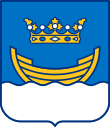| Holy Trinity Church | |
|---|---|
 | |
 | |
| Location | Helsinki |
| Country | Finland |
| Denomination | Eastern Orthodox |
| Website | hos |
| History | |
| Consecrated | 1827 |
| Architecture | |
| Functional status | Active |
| Architect(s) | Carl Ludvig Engel |
| Administration | |
| Diocese | Helsinki |
| Parish | Helsinki Orthodox |
The Holy Trinity Church (Finnish: Pyhän Kolminaisuuden kirkko, Swedish: Heliga Treenighetskyrkan, Russian: Свято-Троицкая церковь) is a Finnish Orthodox Church located in the Kruununhaka district of Helsinki, on the corner of Unioninkatu and Rauhankatu. The church was built in the neo-classical style in 1826 under the direction of the architect Carl Ludvig Engel, and was dedicated and opened in the following year.[1][2] The Holy Trinity services the city's orthodox community with Divine Liturgy held in both Church Slavic and Finnish.[3]
The church is Helsinki's oldest Orthodox church.[4] When Finland became 1808 autonomic Grand Duchy of Finland, a number of Russian civil servants, merchants and soldiers moved to Helsinki. They needed a place for worship, and the czar supported their efforts to get a church. In the 21st century, many of the churchgoers still speak Russian, but majority of them are immigrants born in the Soviet Union.[5]
Gallery[edit]
-
Bell tower
-
Front
-
From the northern side, with Helsinki Cathedral in the background
See also[edit]
References[edit]
- ^ Holy Trinity Church, Helsinki
- ^ "Pyhän Kolminaisuuden kirkko; Kirkkokatu 17 & Unioninkatu 31 & Rauhankatu 18; Helsinki". Finna. Helsinki City Museum. Retrieved 9 November 2016.
- ^ "Pyhän Kolminaisuuden Kirkko" (in Finnish). Helsinki Orthodox Parish. Archived from the original on 10 November 2016. Retrieved 9 November 2016.
- ^ "Holy Trinity Church". Visit Helsinki. Retrieved 9 November 2016.
- ^ "Seurakunta tutuksi". Ortodoksiviesti (in Finnish). Helsinki Orthodox Parish. 2011. Retrieved 9 November 2016.
External links[edit]
- Holy Trinity Church, Helsinki (Homepage). [1]
 Media related to Holy Trinity Church (Helsinki) at Wikimedia Commons
Media related to Holy Trinity Church (Helsinki) at Wikimedia Commons
60°10′16.1″N 24°57′04″E / 60.171139°N 24.95111°E






Well, that’s interesting to know that Psilotum nudum are known as whisk ferns. Psilotum nudum is the commoner species of the two. While the P. flaccidum is a rare species and is found in the tropical islands. Both the species are usually epiphytic in habit and grow upon tree ferns. These species may also be terrestrial and grow in humus or in the crevices of the rocks.
View the detailed Guide of Psilotum nudum: Detailed Study Of Psilotum Nudum (Whisk Fern), Classification, Anatomy, Reproduction